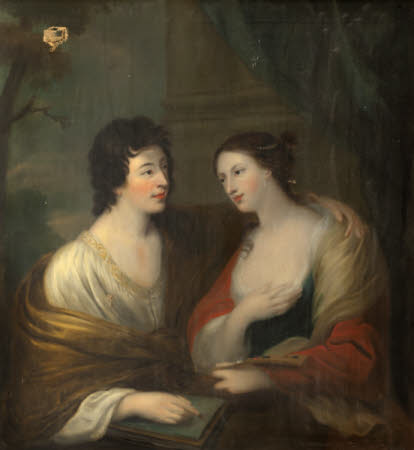Rhoda Delaval, later Lady Astley (1725 - 1757), and her brother, Sir Francis Blake Delaval (1727-71), as ‘Painting and Poetry’ (after Luini)
Rhoda Delaval, Lady Astley (1725 - 1757)
Category
Art / Oil paintings
Date
1745 - 1757
Materials
Oil on canvas
Measurements
1140 x 1150 mm
Order this imageCollection
Seaton Delaval Hall, Northumberland
NT 1276899
Caption
Rhoda Delaval was the oldest of the generation who became infamous as ‘The Gay Delavals’ of Seaton Delaval Hall, Northumberland. While her younger siblings established reputations for lavish theatrical antics, Rhoda channelled her creative energies into becoming an accomplished artist. In February 1744 she began lessons with her family’s favoured portraitist Arthur Pond, who had his studio in London. Throughout the spring and summer months until 1750, Delaval paid Pond a monthly fee of four guineas (the equivalent of around £750 today) for her instruction, plus occasional extras for materials. It was one of the few ways a woman of Delaval’s generation could access professional training. Delaval found her family to be convenient and interesting models, and a number of the works attributed to her are portraits of siblings. One of the most notable is a self-portrait with her brother Francis. In it she portrays herself as ‘Painting’ and Francis, the lively theatre-lover two years her junior, is cast in the role of ‘Poetry’. In 1751 Delaval’s marriage to Edward Astley gave her access to that family’s art collections, enabling her to copy a portrait of their famous ancestor, the Civil War commander Jacob Astley. While such copying was a way of honing technique, it also took skill to achieve convincingly. Delaval’s undoubted talent, her close association with Pond and the lower status traditionally granted to ‘amateur’ endeavour have conspired to limit our understanding of her art. At least six substantial paintings are either attributed to Delaval or could be, if subjected to deeper study. Are there more, perhaps overlooked as the work of either her teacher or another professional? For over a decade Delaval painted intimate glimpses of her family, yet we still understand her best from the chatty, easy-going letters she wrote to her sister-in-law. She died in 1757, at just 32 years old, leaving us a tantalising artistic legacy to explore.
Summary
Oil painting on canvas, Rhoda Delaval, later Lady Astley (1725 - 1757) and her brother, Sir Francis Blake Delaval (1727-71), as ‘Painting and Poetry’ (after Luini) by Rhoda Delaval, Lady Astley (1725 - 1757)
Provenance
Purchased via Private Treaty Sale
Credit line
Seaton Delaval, The Hastings Collection (National Trust)
Makers and roles
Rhoda Delaval, Lady Astley (1725 - 1757), artist after Bernardino Luini (Luini, Lake Maggiore c.1480 – ? Lugano 1532), artist
References
Conroy, Rachel, Women Artists and Designers at the National Trust, 2025, pp. 60-63
